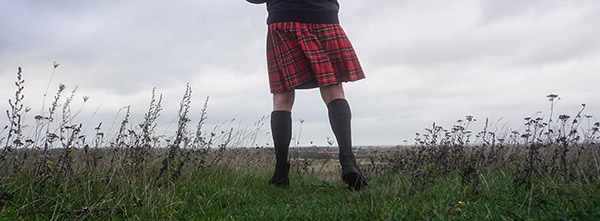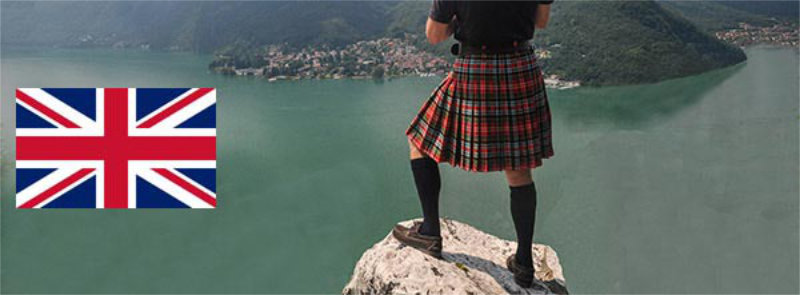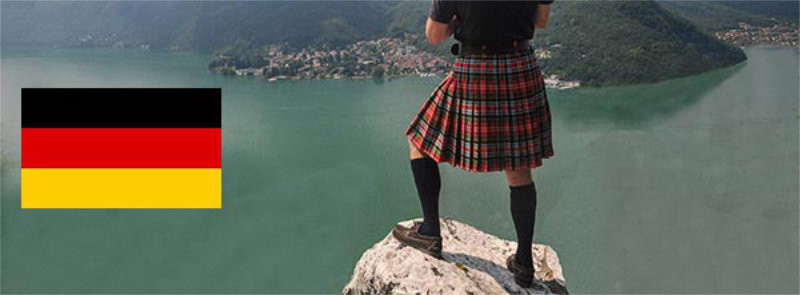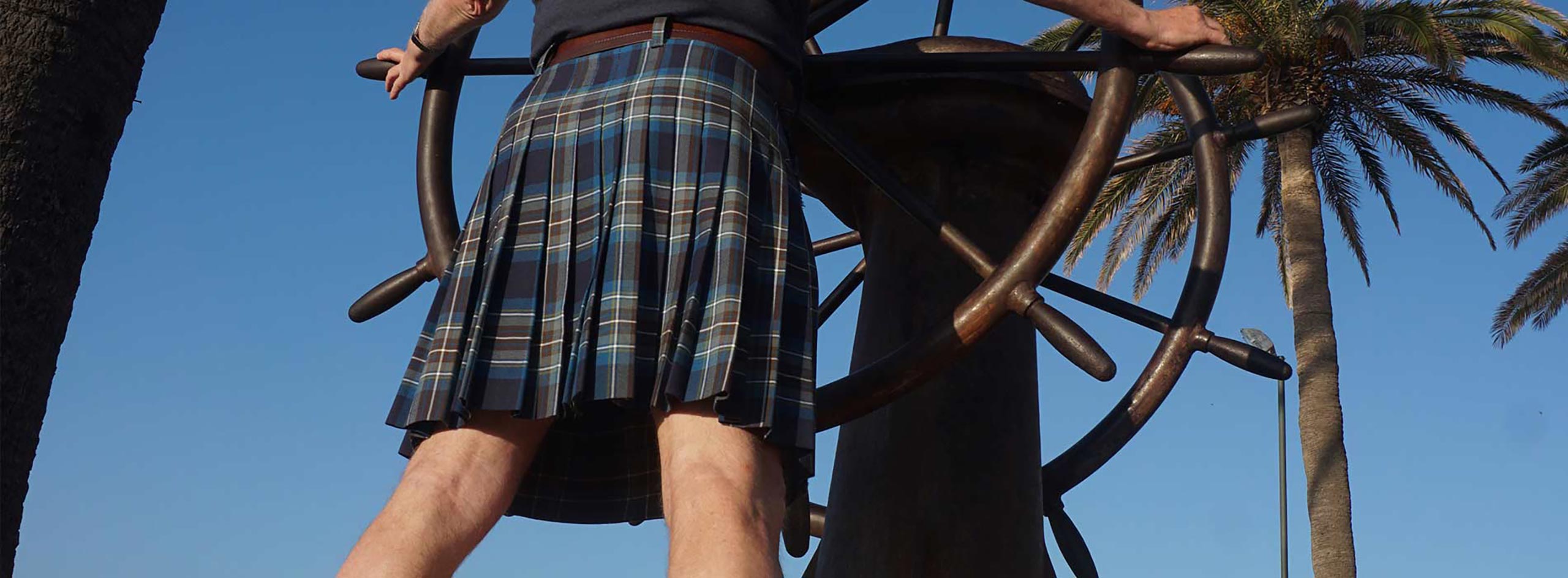
3-yard Kilt, readymade.
Polyviscose, approx. 11 oz.
Holyrood tartan.
Get the measures right
- and order your kilt
Buying your first kilt is something quite unusual. Most likely you shall buy it online, and often it shall be custom made. Most likely this is the first time in your life where you have to take or have taken measures with the purpose of having something sewn to really fit you. It is not difficult, however, and with a kilt there is some give and take; in contrary to trousers.
The measures
When ordering a kilt your are asked for up to five measures. They are:Waist size
Hip size
Fell length
Kilt length
Your height
If you order a ready-made kilt, you only have to inform about your waist size, the length being with 95% probability 24 inches or 61 cm. But then of course, you still have to find out, whether this length shall fit you, but let's take the measurements step by step.
They use yards, feet, and inches
To a continental European it might seem odd, but it is the way it is. And you already know it from jeans. Americans and the British don't use the metric system; at least not for clothing.Fortunately, a recalculation is not difficult.
The basic measure is the inch.
1 inch (1 in or 1") = 2.54 cm
12 inches make a feet
1 feet (1 ft in or 1') = 30.5 cm
3 feet or 36 inches make a yard
1 yard = 91.5 cm
1. WAIST SIZE
A traditional kilt is supposed to sit about navel (your “natural” waist), i.e. higher than most trousers. A casual kilt can be worn lower, however.Take your measure where you want your kilt to sit.
Don’t rely on your trouser size!
The clothing industry, you are used to, is pleasing their customers by lying about facts. My Tommy Hilfiger and Hugo Boss jeans waist size is 32” but my true waist is 36”! And Hilfiger and Boss are NOT alone.
In the kilt world an inch is an inch = 2.54 cm! If you are measuring 36" around your waist and you order your kilt to be 32" in waist size - because your trousers are waist size 32 - the kilt shall be too small, and if you are lucky, ill-fitting.
A kilt being fastened by means of straps and buckles means that there is some flexibility, like plus 2/minus 1 inch. On off-the-peg kilts the flexibility might be even bigger, like for example 34”-38” = 10 cm. But if might not be enough. Therefore, MEASURE.
2. HIP OR SEAT SIZE
It is where you are at the broadest. Take a lose measurement.When buying a readymade kilt you are never asked. Then the seat size is based upon the waist size.
3. FELL LENGTH
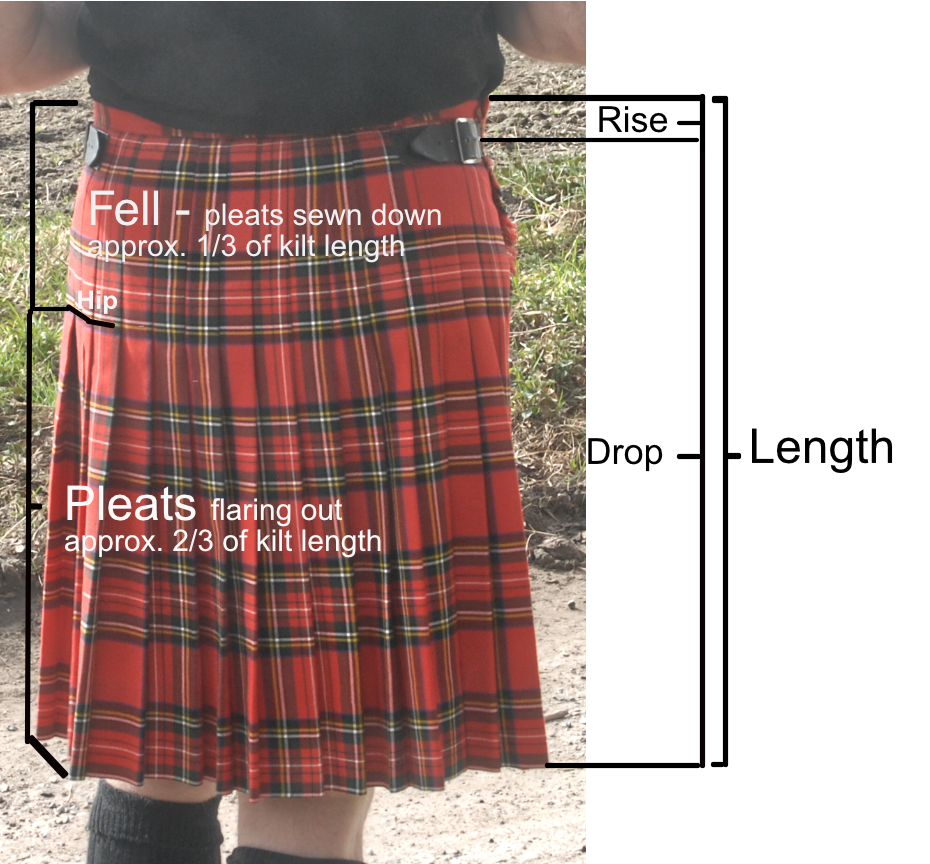
Like mentioned earlier the fell on a kilt is the part where the pleats are sewn down = From top of the kilt till where you are at the broadest = where your hip or seat size are. In fact, you are only asked about it when ordering a made-to-measure kilt in Pakistan, and if a kiltmaker is taking your measures.
Rule of thumb
If your kilt is to sit at your natural waist and it shall reach to the md of your knees, the fell length shall be about 1/3 of the kilt length.
4. KILT LENGTH
The kilt should at the longest end at the middle of your knee cap. By no means should it cover your knees – even if that not uncommon. At the very shortest it should be one inch above the knee. That means a give and take of about five cm or two inches.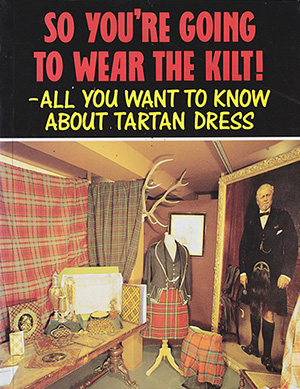
On page 94 he says,

At the very longest, the kilt should reach only to the top of the knee cap… Don’t get the kilt too short, either. One of the books tells of a Highland gentleman who has his heavy kilt that he wears for shooting and hillwalking three inches above his knees. That way it does not touch the calf of his leg at all. That may be all very well if you are going to have a kilt, especially for outdoor sports, but for a general-purpose kilt an inch above the top of the knee cap is probably as short as you will want to go, even if you like a shortish kilt.
J. Charles Thompson: So you're going to wear the kilt, 3rd revised edition 1989, page 54.

Don’t get your kilt too long! The top of the knee cap is the absolute long limit, and up to an inch shorter is acceptable – better in my personal opinion.
J. Charles Thompson: So you're going to wear the kilt, 3rd revised edition 1989, page 99.
A few examples:
A kilt is a most flexible garment. Below are six different kilts, ranging from 24" down to 20", meaning a difference of no less than 10 centimeters, and five of them can be worn according to rules.
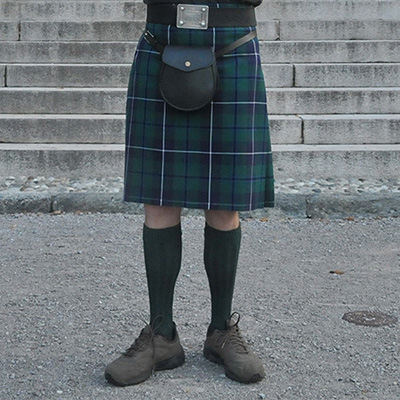
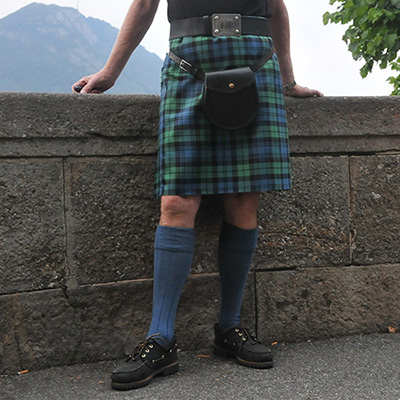
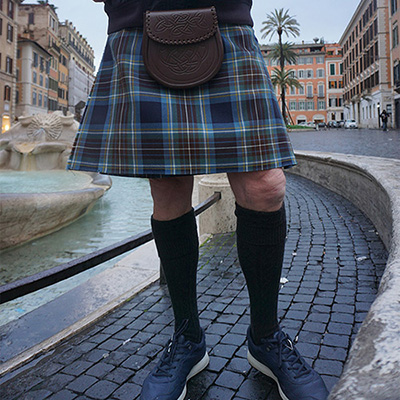
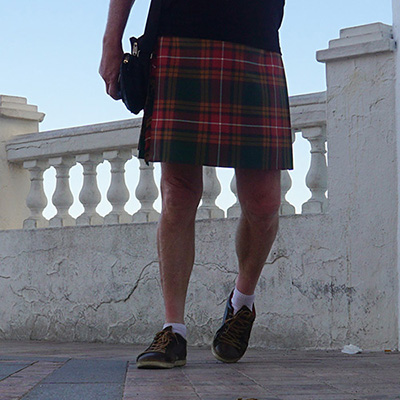
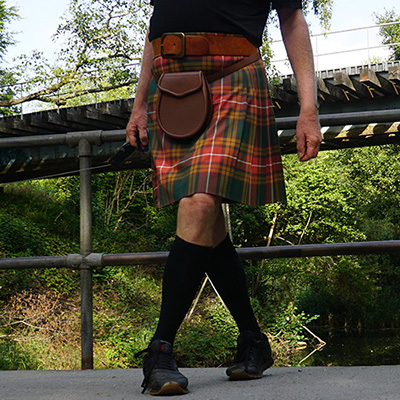
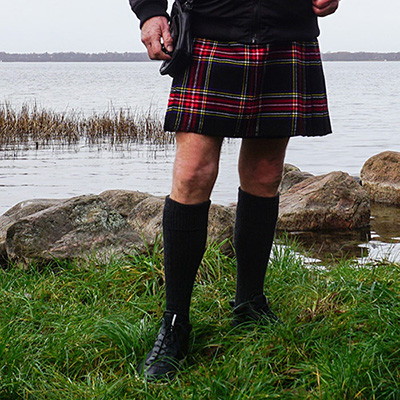
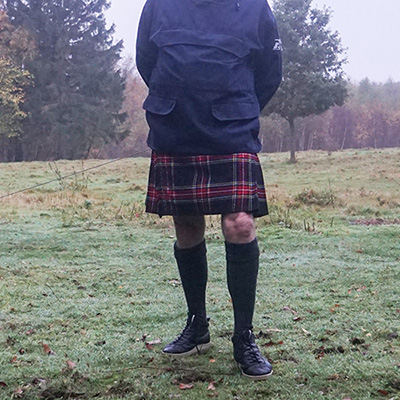
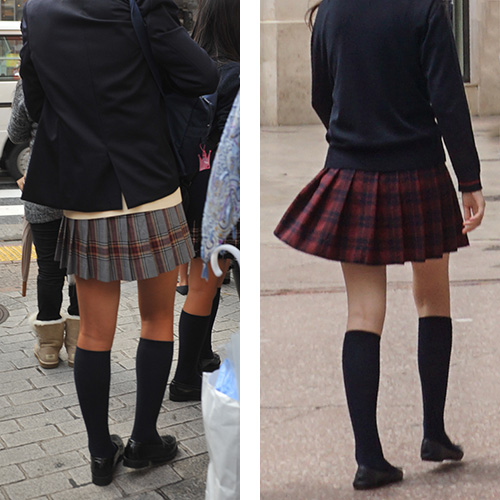
Taking the measure
I have never been able to use the "kneeling" method" often referred to.My advice:
Use a camera or your smartphone, a towel and a belt. The phone or camera should be placed in a vertical position, meaning parallel to the wall and in knee height.
With the belt at navel – or where you should like to fasten your kilt – adjust the towel to the 24” standard length.
With you standing upright (like with your back against the wall) take the picture with the self-timer. If not satisfied adjust the length of the towel until it looks right on the photo and take the measure.
You might also use the smartphone on a selfie stick. Just NEVER lean forward when taking the picture!
Another way is to have your wife or girlfriend assist you.
Be aware that a custom made kilt cannot be returned, just because it does not fit you! A ready-made 24" long kilt can, even if it might have become more complicated to return a kilt from an EU-country to Scotland or wherever it has come from.
Placed at navel a 24” kilt goes to the middle of my knee cap. In my case this length is the absolute maximum. A 21” kilt resting on my hips comes to about one inch above my knee cap, thereby still just acceptable. Fastened at navel it should look more like a mini kilt, however. The perfect kilt length is for me 22.5"-23”. This just to indicate that there is some flexibility – and come in mind we are talking casual kilt wearing, not national dress. I’m 176 cm tall.
For me, better too short than too long.
Rule-of-thumb
If you are of average build, you can expect a kilt being around a third of your height to fit.
Being 176 cm = 69", a third is 23". 23" is for me the perfect length = mid/upper knee cap. To be sure my kilts are at the top of my knees, I order them 22.5" or 22", if half-inch increments are not a possibility.
5. YOUR HEIGHT
Not all vendors will ask. You are supposed to give your height in feet and inches. It is just to give an impression, whether the length you have ordered seems correct. Varying by 2.54 cm it is not a very precise indicator, but if you order your kilt 20” (51 cm) short and your height is 6’9” (206 cm) you might be asked whether you really want it to be a micro mini kilt?1 foot = 30.5 cm.
My 176 cm equal 5' = 152.5 cm plus 9" = 22.9 cm (plus 0.6 cm), meaning I am 5'9" high.
Page revised 2024, June 11.
Next page

Kilt accessories
Which accessories should you wear with your kilt and which are to avoid?
Don't get ripped off on things you don't need. For casual wear they must neither be many nor expensive.
What to find on the Dress2Kilt site?
Every man can wear a kilt, anywhere, anytime
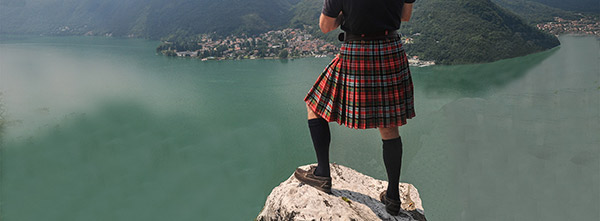
How about a kilt?
Every man can wear a kilt - no need to be Scottish. Whenever YOU feel like it, and appropriate, replace your jeans or shorts by a kilt. Learn about how to take the step. .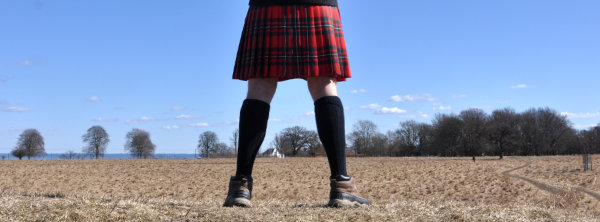
Men in kilts - Q & A
Who will wear a kilt? Why wear a kilt? Where and when? What shall other people say? Is it true? Get the answers to these and many other questions.
Webmaster's kilt story
Learn about the webmaster and his over 25 years as a regular kilt wearer. Why did he start? And how about acceptance from his wife, family, friends?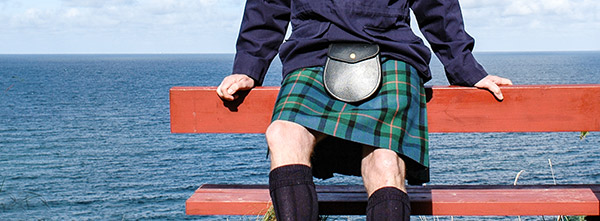
You in a kilt
If you should like to wear kilts, why then not just order a kilt, and start wearing it in pubic? Learn how to handle surroundings and mindset yourself.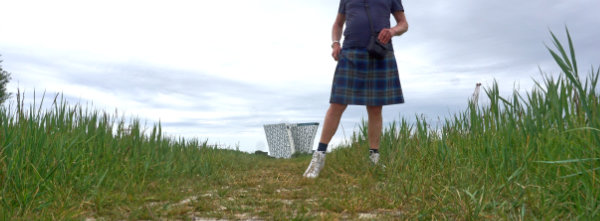
The kilt - is it a skirt?
Never call a kilt a skirt when talking to a Scotsman. But is it? Well, but what difference does it make? Learn about what it takes a skirt to become a kilt.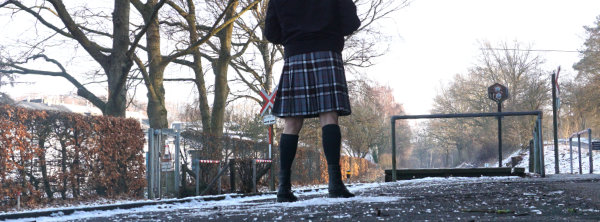
Which kilt for you?
The all-purpose kilt does not exist. Which kilt shall best fit your needs? You may be surprised that it might be quite a lot cheaper than you had feared.
Where to buy a kilt?
There are hundreds of kilt vendors and makers on the internet. And it can be a jungle to find out. Learn where to find good kilts in various price segments.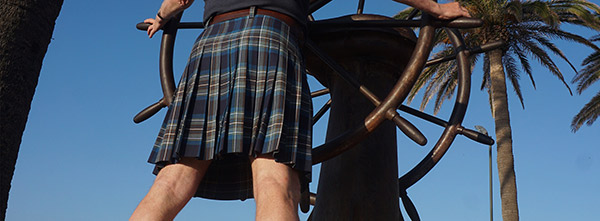
Get the measures right
Probably you shall buy your first kilt online and have it made to your measures. Find out how to get the measures right. It is easier than you think.
Kilt accessories
Which accessories should you buy for your kilt and which to avoid. Don't get ripped off on things you don't need. For casual wear they must not be expensive.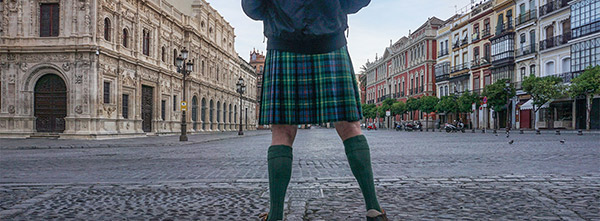
Kilt on!
You have just received your first kilt and some accessories. Learn how to handle all the unfamiliar things.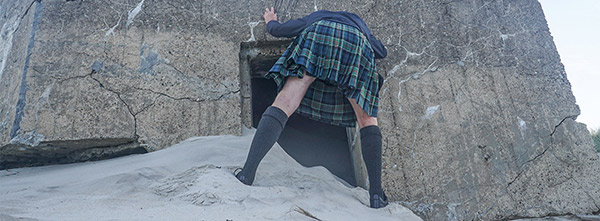
To mind when in a kilt
When in a kilt how about staircases, sitting and sitting down, wind, and people eager to see what you are wearing under it? Learn how to deal with it.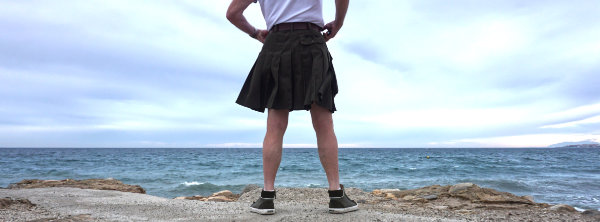
Utility kilts
A utility kilt can make an excellent alternative or a valuable addition to the traditional kilt. What should you know about utility kilts?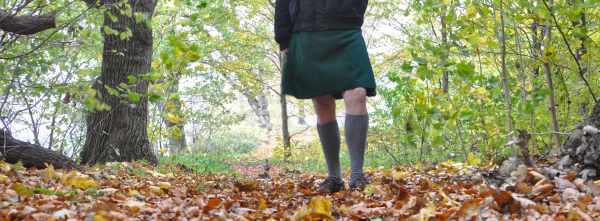
Other kilt variants
Kilts can be solid coloured. Also, instead of wool or PV, the fabric can be tweed. Or how about a kilt in a nice camouflage pattern, or denim, or leather?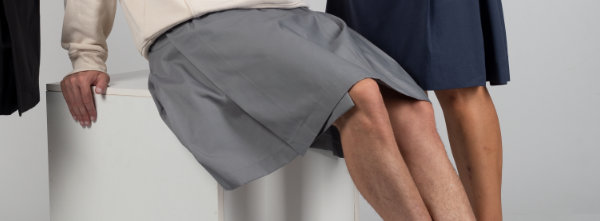
Skirts
Could you as a man wear a skirt? Under circumstances you can. Dedicated man-skirts are on the market, or you can have a skirt designed and made for you.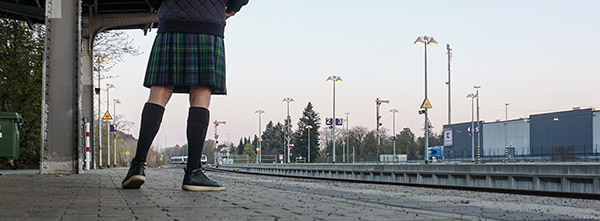
Kilt 24/7/365
Let’s be realistic; most likely, you cannot wear a kilt or a skirt 24/7/365, even if you should want to. But many days a year you can. Learn more about it.Galleries

Introduction
The gallery section - structure,objective, and techique
Tartan kilts
Traditional style. 35 pages with kilts in 35 different tartans.
Solid kilts
Traditional style.Kilts in black, forest green, and light green. 3 pages.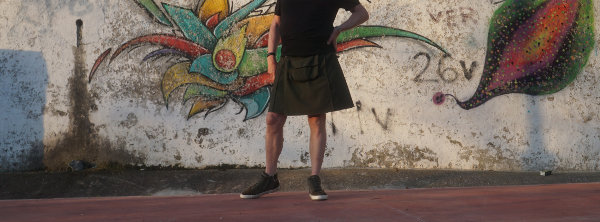
Utility kilts
Eight pages showing eight different utility kilts.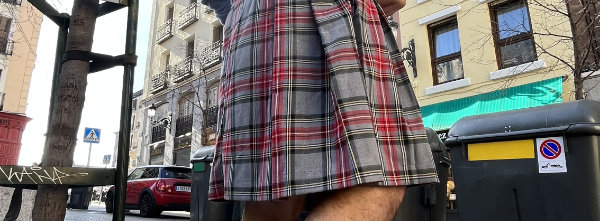
Skirts
Two pages featuring man skirts.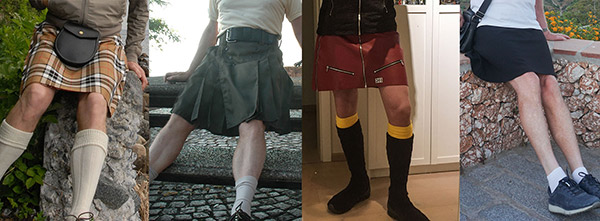
The Braveheart Way
A mix of manly skirted garments.Links

Links #1
Vendors of kilts and accessories, tartan mills, and tartan finders. The most comprehensive links page for kilts on the internet.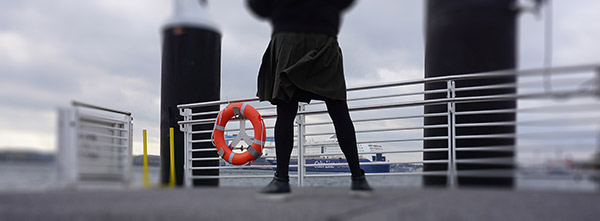
Links #2
Vendors of utility kilts, sarongs, man skirts, unisex skirts, and other skirted garments.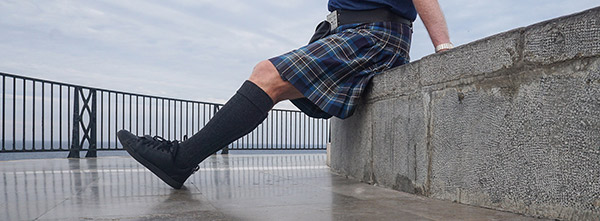
Links #3
Kilt and skirt forums, non-commercial home pages, blogs, picture galleries, videos, articles, men in kilts and skirts on stage and on the catwalk.What's new and back to start - choose your language
